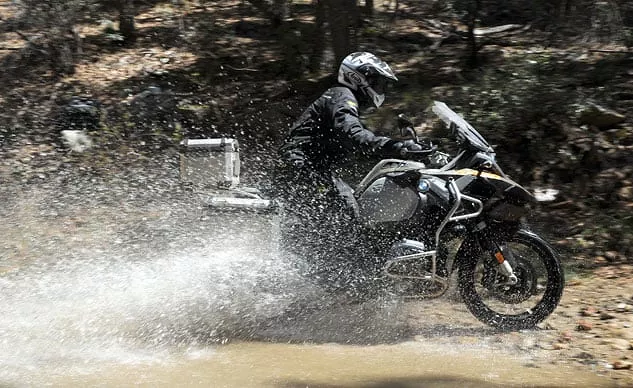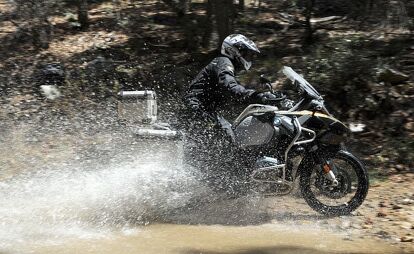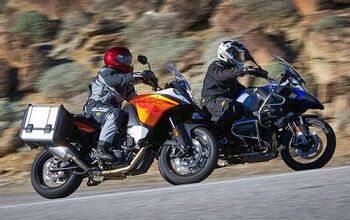2014 BMW R1200GS Adventure Review - First Ride
BMW's top bike for global adventure just got better
Into the river, through the woods, over the mountains, across the desert, down the rabbit hole. When either daydreaming about or participating in two-wheel world travel, BMW’s R1200GS always seems to be at the top of the list. No other motorcycle captures the imagination then lives up to the hype of an exotic, foreign escapade as does BMW’s blue-chip Adventure-Tourer.
2014 BMW R1200GS Adventure
| Engine | 18.5/20 |
| Suspension/Handling | 14/15 |
| Transmission/Clutch | 9.5/10 |
| Brakes | 8.75/10 |
| Instruments/Controls | 5/5 |
| Ergonomics/Comfort | 9.5/10 |
| Appearance/Quality | 10/10 |
| Desirability | 10/10 |
| Value | 7.5/10 |
| Overall Score | 92.75/100 |
At the top of the GS range is the R1200GS Adventure, a more off-road-capable adventurer. Retailing for $21,550 when outfitted with the Premium Package (standard model Adventures only available by special request in North America), it largely depends on your tax bracket whether you’re daydreaming of owning this premier motorcycle. For those who are willing (and able) to afford the Adventure model, knowing if the asking price is worth the investment is antecedent to actually making the purchase.
To help determine this answer we spent a 200-mile day aboard a fully outfitted Adventure of which the majority of those miles were unpaved. Beginning with some of the technical changes, here’s what we found.
As we noted in our 2014 BMW R1200RT Review, there’s only a few, but significant, changes to the precision-cooled Boxer engine from the standard GS. Both the GSA and RT engines share a two-pound increase in crankshaft journal mass, which translates to 20% more crank inertia. The other, specific to the Adventure, is a load reversal damper meant to offset the increased stress caused by the steeper swingarm angle, a result of the increased suspension travel. All other technical aspects about the new Boxer powering the GS and RT can be read in our review of the all-new R1200GS from last year.
At 8.3 inches up front and 8.7 inches out back, the Adventure rides on 0.8 inches more suspension travel than the standard GS. This increase, in order to maintain the same quick steering attributes of the standard GS, elicited a one-degree steepening in rake, from 25.5 degrees of the standard GS to 24.5 degrees on the Adventure. To quell any nervousness from the revised front end, BMW added a hydraulic, non-adjustable steering damper damper that also makes its way onto the standard GS.
The more costly upgrades to the Adventure Premium Package are of the electronic variety, namely Dynamic ESA and Ride Modes Pro. In addition to the Rain and Road riding modes, Ride Modes Pro brings to the table Dynamic, Enduro and Enduro Pro riding modes. Dynamic is for the experienced road rider who wants the best performance the Adventure has to offer when navigating a paved ribbon of asphalt. When using this mode, keep in mind it’s optimized for road tires, not knobby off-road ones – forgetfulness may turn your “minor drifts” into major ones.
Enduro and Enduro Pro modes keep things exciting when riding off-road. Both ABS and TC are On/Off switchable in any ride mode. Selecting Enduro Pro mode leaves TC engaged but minimizes its effect, and switches ABS off on the rear wheel while leaving it engaged for the front wheel. Enduro Pro also optimizes throttle response. BMW says Enduro Pro is for the experienced rider whereas Enduro mode, comparatively, only reduces TC at the rear wheel, maintains ABS on both wheels and smooths throttle response.
For me, what it came to is, after riding the first part of our dirt excursion in Enduro Pro I got tired of wrestling the 575 pounds of claimed wet weight, and decided to take it down a notch and give the Enduro mode a try. What I found was that Enduro mode retained most of the fun of Enduro Pro while making it easier to maintain control of the bike. I was especially appreciative of the smoother throttle response of the Enduro mode. Where in Enduro Pro, I occasionally, unwantedly, twisted too much throttle, which had the adverse effect of suddenly turning the composed big bike into a heavyweight, raging bull. The smoother response of Enduro mode kept the beast within from emerging.
Both Enduro and Enduro Pro are activated by installing a dongle in a receptacle underneath the bike’s seat. A huge benefit after installation is that it’ll keep your settings in place when keying off the bike. Without the dongle installed, the Adventure will default to factory settings (turning TC and ABS back on if turned off) forcing you to reset your preferences each time you restart the motorcycle.
It’s interesting to note that when it comes to suspension, BMW and KTM are working on an inverse premise between the two company’s Adventure-Touring models. Where KTM has ESA on its more streetable 1190 Adventure and old-school clicker suspension on its more off-road R model, BMW has ESA as part of the Premium Package on its Adventure model and non-ESA suspension on the base model Adventure and GS.
COMPARE: 2013 KTM 1190 Adventure R Review
While we enjoy the ease of operation and the functionality of ESA, it might be a concern for a world traveler who may be hundreds of miles from a BMW dealer should something with the electronic suspension fail. If, however, your two-wheel world travels are within the contiguous states of America, you’ve the support of BMW’s extensive dealer network, AAA, cell phone connectivity, etc.
If Dynamic ESA fails, it will typically be in a manner that inhibits changes to the damping and preload settings. Therefore, failure means it simply will not change from its last setting and will function normally in its current setting.
Regardless of where your adventures lead, the R1200GSA includes both electronic and non-electronic niceties to make your trip more comfortable. The first is for those long hauls on endlessly straight freeways on the way to either twisty tarmac or an undulating dirt road. Cruise control is a modern essential on any motorcycle with a touring connotation, and the Adventure has it. The Adventure also employs heated handgrips and tire pressure monitors, both of which aren’t absolutely necessary, but certainly nice to have.
Non-electronic accoutrements include an adjustable windscreen, wide footpegs – which make standing up for long periods so much easier as well as providing better control of the motorcycle when riding off-road – and a capacious 7.9-gallon aluminum fuel tank.
All said, the 2014 BMW R1200GS Adventure is a helluva motorcycle and a value with all its upgrades compared to the previous model. However, at 575 pounds and nearly $22k, the GSA is an expensive and heavy motorcycle when compared to its nemesis, the KTM 1190 Adventure R, which at $16,799 and 519 pounds wet (6.1-gallon fuel tank) is substantially lighter and more affordable.
MID-SIZE: 2014 BMW F800GS Adventure Review
Previous KTM Adventures have always held an advantage in the dirt but lacked essential on-road adornments and comfort prohibiting it from getting the better of the BMW. The new 1190 Adventure has wowed us with its increased all-around performance, and we’ll soon be pitting these two against one another to determine exactly which bike is the current king of Adventure-Touring motorcycles.
+ Highs
- Incredibly agile for such a large off-road motorcycle
- Electronics: Cruise control, Ride Modes, ESA
- The Hummer of Adventure-Touring motorcycles
– Sighs
- Luggage & GPS not included in price
- A lot to wrong with so much electronics
- Heavy for a dirtbike
A former Motorcycle.com staffer who has gone on to greener pastures, Tom Roderick still can't get the motorcycle bug out of his system. And honestly, we still miss having him around. Tom is now a regular freelance writer and tester for Motorcycle.com when his schedule allows, and his experience, riding ability, writing talent, and quick wit are still a joy to have – even if we don't get to experience it as much as we used to.
More by Tom Roderick















































Comments
Join the conversation
Love reading all the comments where people are putting this bike down.. the machine is amazing and maybe should only be bought by the people who can afford it.. klr's drz's v-stroms all cheap and cheerful and feel it too next to a BMW.
Anyone has experienced with Low suspension and Low seat version. I'm 182 cm with inseam 32. Would i be fine with it? (I have no other option the only model available in my country is Low suspension and low seat version for 2015)